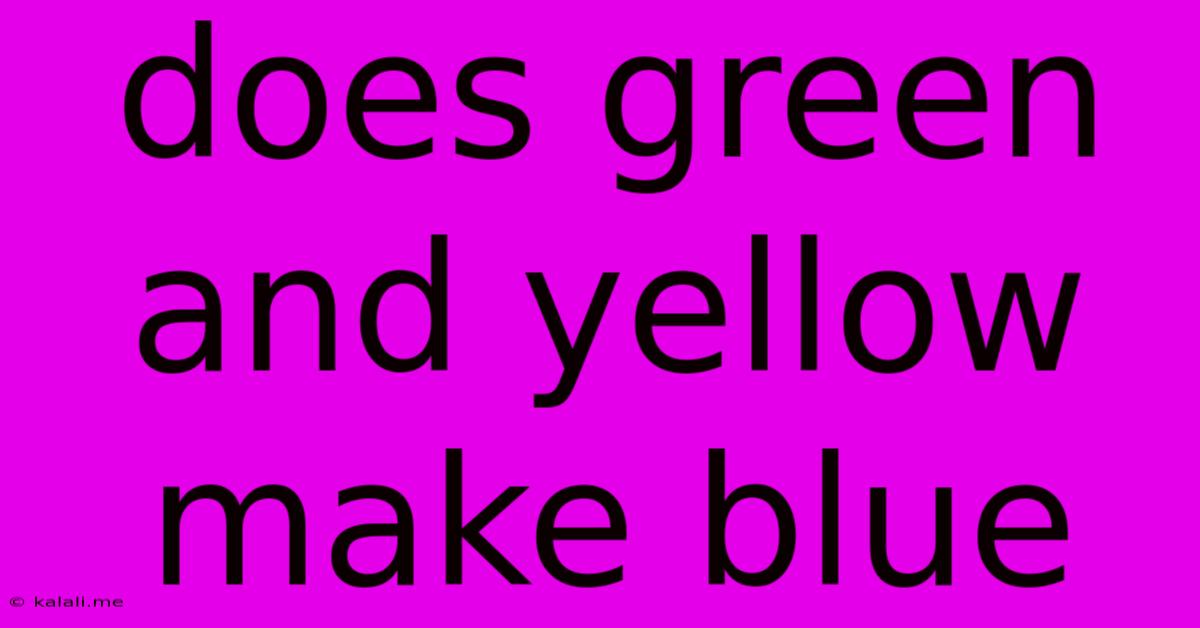Does Green And Yellow Make Blue
Kalali
Jun 03, 2025 · 3 min read

Table of Contents
Does Green and Yellow Make Blue? Debunking a Common Color Mixing Myth
Meta Description: Discover the truth behind the common misconception that mixing green and yellow creates blue. We explore the science of color mixing and explain why this combination doesn't yield the desired result. Learn about primary and secondary colors and how they interact.
Many people mistakenly believe that mixing green and yellow paint will result in blue. This common misconception stems from a misunderstanding of how colors mix, specifically the difference between additive and subtractive color mixing. The short answer is: no, green and yellow do not make blue. Let's delve deeper into the science behind color mixing to understand why.
Understanding Additive vs. Subtractive Color Mixing
The way colors combine depends on whether we're talking about light (additive) or pigments (subtractive).
-
Additive Color Mixing: This applies to light sources like screens and projectors. The primary colors in additive mixing are red, green, and blue (RGB). Mixing these primary colors produces secondary colors: red + green = yellow, red + blue = magenta, and green + blue = cyan. Mixing all three primary colors creates white light.
-
Subtractive Color Mixing: This is what happens when we mix paints, inks, or dyes. The primary colors here are red, yellow, and blue (RYB – a simplification used in art). Mixing these primary colors creates secondary colors: red + yellow = orange, yellow + blue = green, and red + blue = purple (violet). Mixing all three primary colors theoretically results in a dark brown or black, as each pigment absorbs more light.
The confusion often arises because the RYB color model, used traditionally in art, is a simplification. It doesn't perfectly represent the complex interactions of pigments. The true primary colors for subtractive mixing are closer to cyan, magenta, and yellow (CMY), which aligns more closely with the behavior of inks and paints.
Why Green and Yellow Don't Make Blue
Since we're discussing mixing paints (subtractive color mixing), let's consider the RYB model. Green is already a secondary color created by mixing yellow and blue. Adding more yellow to green will simply result in a lighter or yellower green, not blue. To get blue, you'd need to start with a blue pigment.
The idea that green and yellow make blue is a misconception perpetuated through simplification and inconsistent color models. The actual result of mixing green and yellow paint will be a shade of green, varying in lightness and saturation depending on the specific pigments used.
Experimenting with Colors: A Practical Approach
The best way to understand color mixing is through experimentation. Try mixing various colors yourself using paints or food coloring. You'll quickly see that the results don't always align with simplistic assumptions. Observe how different pigments interact and how subtly changing the ratio of each color dramatically alters the final result. This hands-on experience is invaluable in grasping the nuances of color theory.
In conclusion, the statement "green and yellow make blue" is incorrect, especially when referring to mixing paints. Understanding the principles of additive and subtractive color mixing clarifies why this combination doesn't produce blue. Experimentation remains the key to mastering color mixing and appreciating the intricacies of color relationships.
Latest Posts
Latest Posts
-
Jpeg And Mp3 Compression Use Entropy
Jun 05, 2025
-
What Voltage Is A Cell Phone Jack In A Car
Jun 05, 2025
-
Contents In The Ark Of The Covenant
Jun 05, 2025
-
Cron Info No Mta Installed Discarding Output
Jun 05, 2025
-
He Was Meant To Be The Best Of Us
Jun 05, 2025
Related Post
Thank you for visiting our website which covers about Does Green And Yellow Make Blue . We hope the information provided has been useful to you. Feel free to contact us if you have any questions or need further assistance. See you next time and don't miss to bookmark.